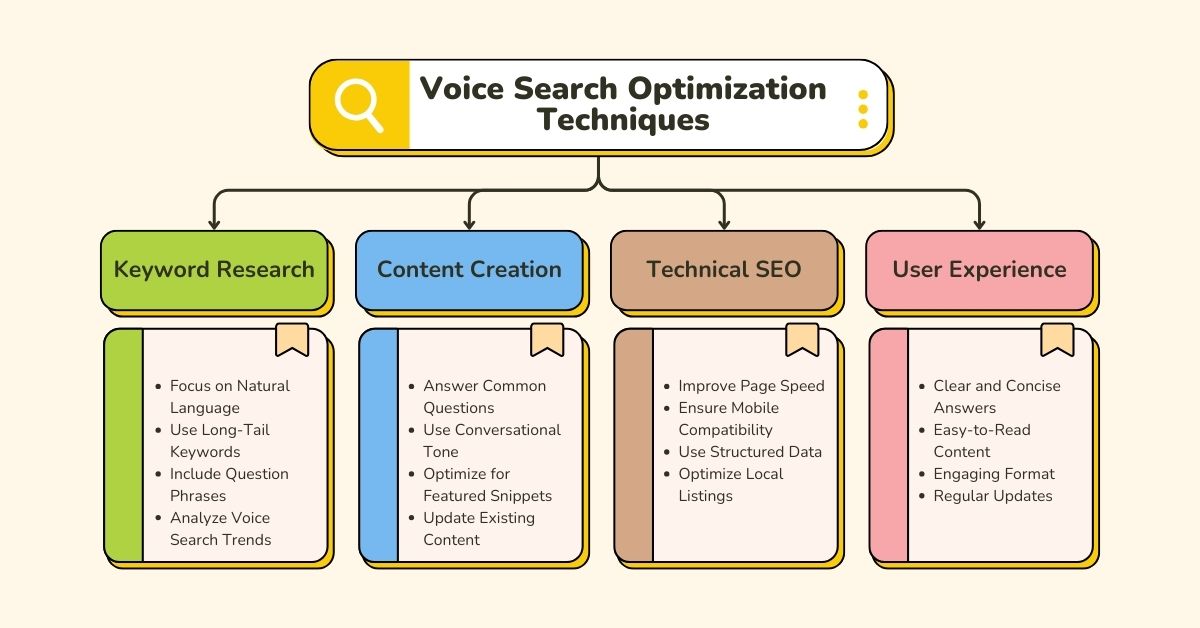In the ever-evolving landscape of digital marketing, voice search has emerged as a game-changer for SEO strategies. With the growing adoption of virtual assistants like Siri, Alexa, and Google Assistant, users are increasingly turning to voice queries to find answers quickly and conveniently. This shift in search behavior has pushed businesses to rethink how they optimize their content to stay competitive in search engine rankings.
As we move into 2024, voice search optimization is no longer optional—it is essential. The rise of AI-powered tools and conversational search patterns has made traditional SEO techniques less effective for voice-based queries. Businesses that fail to adapt risk losing valuable organic traffic and customer engagement. Understanding and implementing effective voice search optimization techniques can help businesses capture this growing audience and achieve long-term success in their digital marketing efforts.
In this article, we’ll explore:
- What voice search optimization is and why it matters.
- Practical techniques to optimize your website for voice search optimization techniques.
- Tools and strategies to stay ahead of the competition.
- Real-life examples and future trends to watch in 2024.
Let’s dive in and unlock the potential of voice search for your business!
What is Voice Search Optimization?
Voice search optimization refers to the process of enhancing your website and content to rank for queries made through voice-enabled devices like smartphones, smart speakers, and virtual assistants. Unlike traditional text-based searches, voice search relies on conversational language and natural phrasing, making it essential for businesses to adapt their SEO strategies to cater to these unique patterns.
Understanding Voice Search Technology
How Voice Search Differs from Text Search
Voice search operates differently from text search in several ways:
- Conversational Queries: Voice searches are typically phrased as complete sentences or questions, reflecting natural human speech. For example, a text search might be “best restaurants near me,” while a voice search might say, “What are the best restaurants near me?”
- Longer Keywords: Voice queries often use long-tail keywords, which are more specific and detailed than their text-based counterparts.
- Real-Time Context: Voice-enabled devices often consider factors like location, time of day, and user preferences to deliver more personalized results.
By understanding these differences, businesses can tailor their SEO strategies to align with how users interact with voice search platforms.
The Role of AI and Natural Language Processing (NLP)
AI and NLP are at the heart of voice search optimization techniques. They work together to understand and interpret human language in a way that feels natural. Key elements include:
- Speech Recognition: AI algorithms convert spoken words into text that can be processed.
- Intent Recognition: NLP helps devices understand the context and intent behind queries, even if phrased ambiguously.
- Semantic Search: AI ensures results are contextually relevant by analyzing user behavior and patterns.
This technological foundation enables devices to provide accurate and user-friendly results, pushing businesses to optimize content for conversational and intent-driven searches.
Why Voice Search Matters for SEO
Growth Statistics for Voice Search
Voice search is no longer a futuristic concept—it’s a mainstream tool driving search behavior today. Consider these eye-opening statistics:
- By 2024, an estimated 50% of all online searches will be voice-driven.
- Nearly 40% of adults use voice search at least once a day.
- The smart speaker market continues to grow, with 55% of households expected to own a voice-activated device by the end of the year.
These figures highlight the increasing reliance on voice search, making it critical for businesses to optimize their digital presence accordingly.
How Voice Search Impacts User Behavior and Engagement
Voice search is shaping how users interact with content in several significant ways:
- Faster Queries: Users expect instant answers, often relying on voice search for quick and concise information.
- Increased Local Intent: A significant proportion of voice searches are location-based, such as “Where is the nearest coffee shop?” or “What’s the best pizza place around here?”
- Enhanced Engagement: By providing accurate and personalized responses, voice search optimization techniques builds stronger trust and engagement between businesses and consumers.
Incorporating voice search optimization into your SEO strategy ensures that your content aligns with these evolving user behaviors, helping you capture a larger share of this growing audience.
Optimize for Conversational Keywords
Importance of Long-Tail and Natural Phrases
Voice search users tend to phrase queries in a conversational and detailed manner, unlike the short, fragmented keywords used in text searches. Optimizing for long-tail keywords ensures your content aligns with how people naturally speak. For example:
- Text Search: “weather today”
- Voice Search: “What’s the weather like today in New York?”
By focusing on natural, question-like phrases, you can match the user’s intent and improve your ranking in voice search results.
Example Keyword Optimization for Voice Queries
To optimize for voice, incorporate these strategies:
- Use tools like AnswerThePublic or Google’s People Also Ask section to find common questions.
- Optimize content around conversational phrases, such as:
- “How to bake a chocolate cake at home?”
- “Where is the best Italian restaurant near me?”
Integrating these conversational keywords into headings, meta descriptions, and body text improves visibility in voice search.

Image Source Credit: Pexels.com
Leverage Local SEO
The Connection Between Voice Search and Local Intent
A significant proportion of voice searches are local, with users frequently asking questions like “Where can I find a car repair shop nearby?” or “What time does the closest pharmacy open?” Optimizing for local SEO ensures you capture these highly relevant and intent-driven searches.
Steps to Optimize Google My Business (GMB) for Voice Search
- Claim and Verify Your GMB Profile: Ensure your business listing is complete and accurate.
- Include Accurate NAP (Name, Address, Phone): Consistency across platforms builds trust with search engines.
- Optimize Business Categories: Select the most relevant categories for your business.
- Use Keywords in Your Business Description: Add natural, conversational phrases relevant to your industry.
- Encourage Reviews: Positive reviews boost credibility and voice search rankings.
Improve Website Speed and Mobile Friendliness
The Impact of Page Load Speed on Voice Search Rankings
Voice search users expect instant results, and slow-loading pages can lead to a poor user experience. Google prioritizes fast-loading sites in voice search rankings. Use tools like Google PageSpeed Insights to identify and fix performance issues, such as:
- Optimizing images
- Enabling browser caching
- Reducing server response time
Mobile-First Design for Better User Experience
Most voice searches are performed on mobile devices, making mobile-first design essential. Key steps include:
- Using responsive design to ensure seamless access on all screen sizes.
- Avoiding intrusive pop-ups that disrupt user experience.
- Ensuring easy navigation with thumb-friendly buttons and clear CTAs.
Structure Your Content for Featured Snippets
Importance of Position Zero for Voice Search
Voice assistants often pull answers from featured snippets, also known as “position zero.” Optimizing for this spot dramatically increases your chances of being the spoken answer to a query.
How to Create Content That Answers Questions Directly
- Use Clear Headings: Frame content as questions (e.g., “What is the best way to clean a carpet?”).
- Provide Concise Answers: Answer the question in 40-60 words, then elaborate if necessary.
- Include Lists and Tables: Structured data helps search engines understand your content better.
Enhance Site Accessibility
Using Schema Markup for Better Crawling
Schema markup helps search engines understand the context of your content, making it easier for voice assistants to retrieve relevant information. Examples include:
- LocalBusiness schema: For business details like hours and location.
- FAQ schema: To highlight commonly asked questions and answers.
Optimizing Meta Descriptions and Alt Texts
- Write compelling meta descriptions using conversational keywords.
- Add descriptive alt texts to images to improve accessibility for both users and search engines.
Focus on Natural Language and FAQs
Writing Content with Conversational Tones
Adopt a conversational tone in your content to align with the natural phrasing of voice queries. For instance:
- Use simple, clear sentences.
- Avoid overly technical jargon unless necessary.
Creating a Dedicated FAQ Section to Answer Common Queries
- List out frequently asked questions relevant to your audience and industry.
- Provide straightforward answers in the form of short paragraphs or bullet points.
- Regularly update the FAQ section to address emerging trends or queries.
By focusing on these techniques, you can create a website that not only ranks well for voice search but also delivers a superior user experience.
Best Tools for Keyword Research in Voice Search
Google’s Keyword Planner
Google’s Keyword Planner is a foundational tool for identifying keywords relevant to your audience. While it’s traditionally used for text search, you can leverage it for voice search by focusing on:
- Long-tail keywords: Identify phrases that mimic conversational queries.
- Question-based suggestions: Use filters to find question-related keywords like “how to,” “where is,” or “what’s the best.”
Tips for using Keyword Planner:
- Input broad terms related to your industry to see long-tail variations.
- Check search volume trends for voice-friendly keywords.
SEMrush and Ahrefs for Long-Tail Keywords
SEMrush and Ahrefs are premium SEO tools that excel in identifying long-tail and question-based keywords. Their features include:
- Keyword Gap Analysis: Discover what keywords your competitors rank for in voice search.
- Questions Feature: SEMrush and Ahrefs highlight questions people are asking, which are perfect for optimizing voice search content.
- Search Intent Insights: Identify user intent behind queries, helping you craft content that directly answers spoken questions.
Using these tools ensures you target the exact phrases users are likely to speak, improving your chances of ranking for voice queries.
Tools for Analyzing Website Performance
Core Web Vitals and Google Search Console
Optimizing your site’s performance is critical for voice search rankings, and Google Search Console and Core Web Vitals are essential for monitoring and improving your website’s health. Key benefits include:
- Core Web Vitals: Measures performance indicators like page load speed, interactivity, and visual stability, all of which are crucial for voice search optimization.
- Search Console Reports: Provides insights into mobile usability, indexing issues, and organic keyword performance.
Steps to use these tools:
- Regularly check your Core Web Vitals scores for pages with high voice search potential.
- Fix any issues flagged in Google Search Console, such as slow-loading pages or mobile usability errors.
Tools for Checking Mobile Responsiveness
Since most voice searches occur on mobile devices, ensuring mobile responsiveness is vital. Here are some tools to help:
- Google’s Mobile-Friendly Test: Analyze whether your website provides a seamless experience on mobile.
- GTmetrix: Evaluate page load speed and identify bottlenecks that might affect mobile users.
- Pingdom: Assess overall site performance and identify areas for improvement.
By using these tools, you can ensure your website is technically optimized for voice search, providing users with fast, relevant, and accessible content.
Examples of Brands Excelling in Voice Search
Case Studies and Best Practices
- Domino’s Pizza
Domino’s has been a leader in leveraging voice search for customer convenience. Through integrations with Google Assistant and Alexa, they allow users to place orders using simple voice commands.- Best Practices:
- Focused on conversational keywords like “Order pizza near me” or “Domino’s delivery options.”
- Optimized local SEO to connect customers with the nearest branch.
- Streamlined ordering processes for a fast, seamless experience.
- Best Practices:
- Nestlé
Nestlé optimized its recipes for voice search, ensuring users could easily access cooking instructions via smart assistants.- Best Practices:
- Structured content with schema markup for easy retrieval.
- Answered common questions like “How do I make chocolate chip cookies?” in short, conversational snippets.
- Created voice-friendly content tailored to “How-to” queries.
- Best Practices:
- John Deere
The agricultural equipment giant implemented voice search optimization to cater to farmers seeking quick solutions while on the go.- Best Practices:
- Used FAQs and detailed product guides to answer questions like “How to maintain a John Deere tractor?”
- Focused on mobile-first design, knowing most voice searches occurred in the field.
- Enhanced site speed and accessibility for better rankings.
- Best Practices:
Insights into Their Strategies and Tools
- Conversational Content: All these brands focused on creating content that mirrors natural speech patterns.
- Local SEO Optimization: Whether through Google My Business or localized keywords, they ensured relevance to geographically-specific searches.
- Schema Markup: Using structured data to make their content easily understandable for search engines and voice assistants.
- Smart Assistant Integration: Brands like Domino’s directly integrated their services with voice assistants, creating frictionless customer experiences.
- Analytics and Iteration: Regular use of tools like Google Analytics, SEMrush, and Ahrefs to refine strategies based on performance data.
By adopting similar techniques and tools, businesses can replicate these success stories and thrive in the era of voice search.
AI and Its Evolving Role in Voice Search
Artificial Intelligence (AI) continues to redefine voice search optimization techniques by improving the accuracy and personalization of search results. Key trends include:
- Contextual Understanding
AI is becoming better at understanding context, enabling it to decipher nuanced queries. For example:- A user asking, “What are the best Italian restaurants?” followed by “What about nearby?” will receive relevant results thanks to AI’s ability to link these queries contextually.
- Voice Cloning and Natural Language
AI-powered voice assistants are evolving to sound more human, enhancing user experience and engagement. This also encourages businesses to craft content in conversational tones that align with how people speak. - Personalization
AI analyzes user behavior, preferences, and location to deliver tailored results. Businesses need to leverage this by providing personalized content that resonates with individual users.
Multimodal Searches Combining Voice, Text, and Visuals
Voice search is moving beyond standalone queries to multimodal interactions that combine voice, text, and visuals for a richer user experience. Key developments include:
- Smart Displays
Devices like Amazon Echo Show and Google Nest Hub allow users to see visual results for voice queries, such as:- Recipes displayed on-screen after asking, “How do I make lasagna?”
- Interactive maps and directions following queries like, “What’s the quickest route to downtown?”
- Visual Search Integration
Pairing voice search with visual search tools (e.g., Google Lens) is becoming more prevalent. For instance, users might say, “What is this plant?” while pointing their smartphone camera at it. - Enhanced E-commerce Experiences
Retailers are combining voice commands with visuals to improve shopping. For example, users can ask, “Show me red dresses under $50,” and see curated options displayed on their devices.
To prepare, businesses should optimize their content for both visual and voice formats, ensuring images, videos, and text are accessible and relevant.
Preparing for Smart Devices and IoT Integrations
As Internet of Things (IoT) devices proliferate, voice search optimization techniques are becoming a critical interface for managing smart homes, offices, and even cities. Future trends include:
- Seamless Connectivity
Smart devices, from refrigerators to cars, are integrating voice capabilities, allowing users to:- Ask their fridge, “Do I need more milk?” or
- Query their car, “What’s the best route to work today?”
- Voice-Activated E-commerce
IoT devices are facilitating purchases through voice commands. Businesses need to ensure their products are voice-search-friendly and included in assistant databases like Amazon Alexa Skills or Google Actions. - Hands-Free Operations
Industries like healthcare and manufacturing are adopting voice-enabled IoT devices for hands-free operations. For example:- Surgeons may use voice commands to access patient data during procedures.
- Warehouse staff can manage inventory through voice-integrated systems.
How to Prepare:
- Optimize content for IoT-enabled platforms.
- Develop skills or actions for voice assistants to interact with your products or services.
- Focus on real-time updates and local search optimization to stay relevant in voice-driven IoT ecosystems.
By aligning with these trends, businesses can future-proof their SEO strategies and position themselves as leaders in the revolution of voice search optimization techniques.
Conclusion
Voice search is no longer a novelty—it’s a powerful driver of user engagement and search engine rankings in the modern digital landscape. Optimizing for voice search requires businesses to adapt their strategies to match conversational queries, focus on mobile-first and local SEO, and leverage emerging technologies like AI and schema markup.
Recap of the Key Takeaways
- Understanding Voice Search: Voice search optimization techniques relies on conversational language and AI-driven algorithms to provide fast, personalized results.
- Optimization Techniques: Effective strategies include targeting long-tail keywords, enhancing website speed and mobile friendliness, and structuring content for featured snippets.
- Future Trends: Businesses must prepare for multimodal searches, smart device integration, and the continued evolution of AI in voice search.
Call-to-Action
Now is the time to implement these voice search optimization techniques to stay ahead in 2024. Start by auditing your website for voice search readiness, updating content to match conversational queries, and investing in tools that support this evolving technology. By acting today, you can ensure your business captures the growing voice search audience and maintains a competitive edge in the digital market.
Ready to enhance your SEO game? Start optimizing for voice search and lead the way into the future of search technology!








Add comment